I had a couple of extra days to go birding in Australia before embarking on a 3 week birding excursion with Rockjumper Tours in Papua/New Guinea. I made arrangements for guiding services in Australia with Carol Probets of the Katoomba area. I took the train from the Sydney airport to Windsor where she met me and we began our birding in the Hawkesbury area a little before noon on July 13th.
Early in the drive out of Windsor we spotted Masked Lapwings, Spotted Doves, Galahs, Magpie Larks, lots of Willie Wagtails, Australian Magpies, Pied Currawongs, Australian Ravens, Australian Pipits, Common Starlings, Common Mynahs and Welcome Swallows. We stopped for cookies and tea at a small park with significant water features. There we got close-up looks at quite a variety of water birds and some passerines: Black Swans, Pacific Black Ducks, Eurasian Coots,
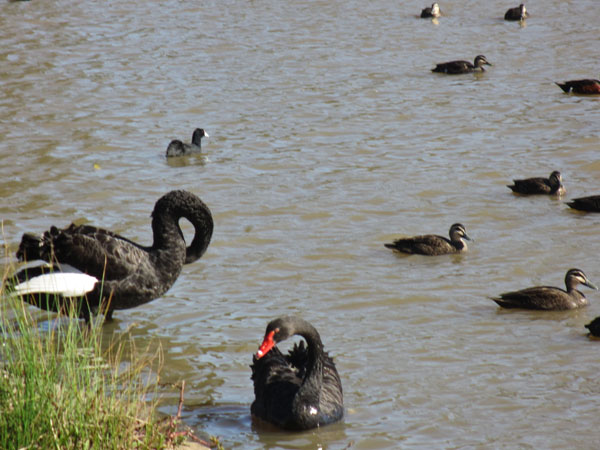
Grey Teal, Chestnut Teal, Hardheads, Australasian Grebes, Australasian Darters, Australian Pelicans, Intermediate Egrets, Cattle Egrets, a Royal Spoonbill, Purple Swamphens, Dusky Moorhens, a pair of fly-over Yellow-tailed Black Cockatoos, Superb Fairy Wrens, a Brown Thornbill, and Red-browed Finches.
We made our way slowly into the beautiful Capertee Valley in order to arrive at our lodging for the night, the Binalong Cottage.

We arrived as it was beginning to darken. Along the way we saw Australian Wood Ducks, a Brown Falcon, a White-faced Heron, Crested Pigeons, a scruffy looking Wombat, Crimson Rosellas, Little Wattlebirds, Noisy Miners, Lewin’s Honeyeater, White-plumed Honeyeaters, a Grey Fantail, Grey Butcherbirds, and some Red-whiskered Bulbuls.
In the morning I was treated to a look at a troop of Eastern Grey Kangaroos foraging in the grasslands close by the Cottage.
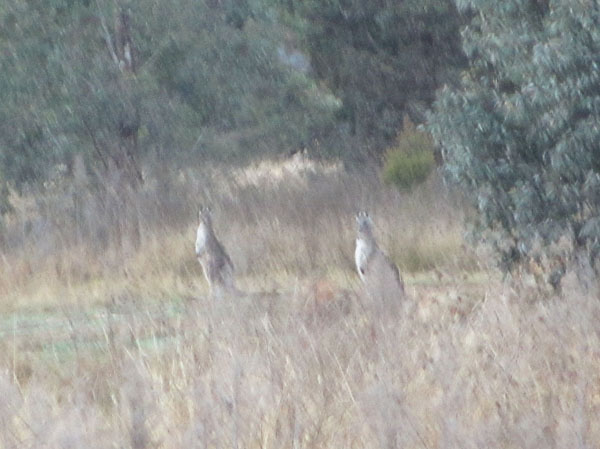
They were quite wary and disappeared quickly once they knew they were being observed. They are accustomed to being hunted by the local farmers. Before breakfast we walked along the trails and roads near the Cottage. Birds were plentiful and we saw an Australian Hobby, more Crested Pigeons, Peaceful Doves, more Galahs, Little Corellas, Sulphur-crested Cockatoos,
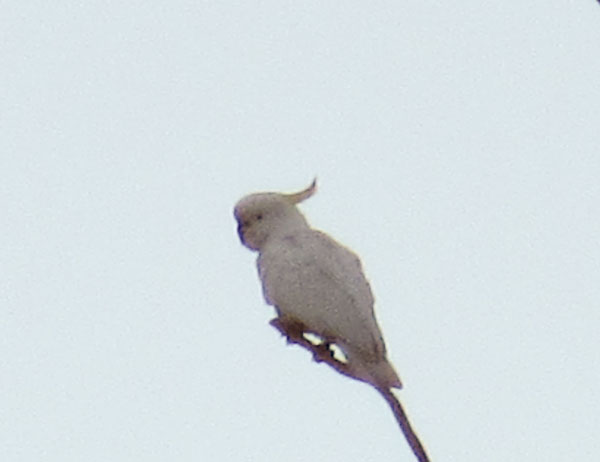
a Laughing Kookaburra, Brown Treecreepers, Yellow-rumped Thornbill, Striped Honeyeaters, Noisy Friarbirds, Fuscous Honeyeaters, Jackie Winters, an Eastern Yellow Robin,
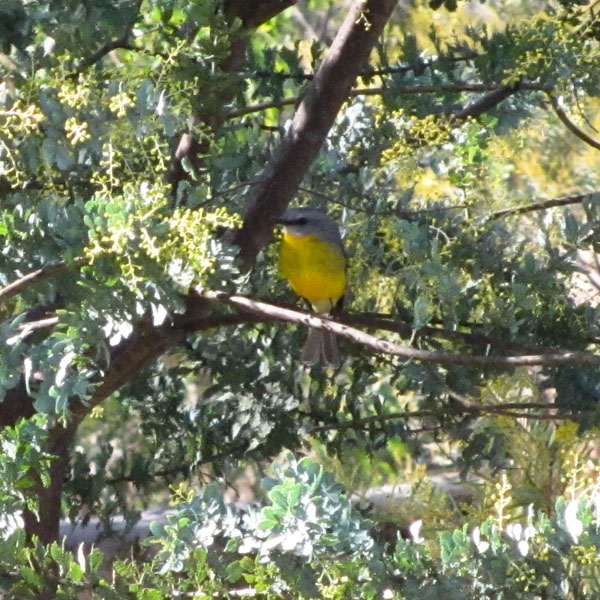
Grey Shrike-thrushes, Restless Flycatchers, a nice flock of White-winged Choughs, Zebra Finches, Double-barred Finches, Diamond Firetails, and Tree Martins. The undoubted “best bird” of the day, however, was the Regent Honeyeater, an endangered and beautiful bird. Actually, we saw at least 6 of them, and my Guide, Carol, was quite excited to find them present in such unusual numbers. The Binalong Cottage is part of a larger farm which has been dedicated to plantings of native trees and shrubs designed to help the Regent Honeyeaters survive.
In the afternoon we drove to Katoomba where I had reservations at the Three Sisters Motel. Along the way we stopped to look for birds, of course. Among those seen on this segment were Musk Ducks (very odd ducks), Australasian Shovelers, Pink-eared Ducks, Hoary-headed Grebes, Little Pied Cormorants, Little Black Cormorants, a White-necked Heron, a superb Wedge-tailed Eagle, Eastern Rosellas, Red-rumped Parrots, Red Wattlebirds, Yellow-faced Honeyeaters, Black-chinned Honeyeaters, and Common Wallaroos.
The next morning in Katoomba broke cold and very windy, so we headed down into some protected ravines and valleys. We only had the morning for birding as Carol had another client scheduled at noon. Our primary target bird was the Australian endemic, the beautiful and strange Superb Lyrebirds. They were quite vocal but very hard to see. After a lot of effort we succeeded in tracking down a displaying male in the underbrush of a heavily wooded ravine. Although I got a decent look at it, I was not able to get any sort of a picture. Nevertheless, it was a satisfying look at a bird that I remember admiring, sketched in the old unabridged Dictionary that stood on a pedestal in my country school house at Highland Township Number 1 in northern Iowa.
Grey-Shrike Thrushes were out in good numbers along the narrow park roads. Other birds seen that morning were more Yellow-tailed Black Cockatoos and Galahs, a White-throated Treecreeper, a Red-browed Treecreeper, Rockwarblers,
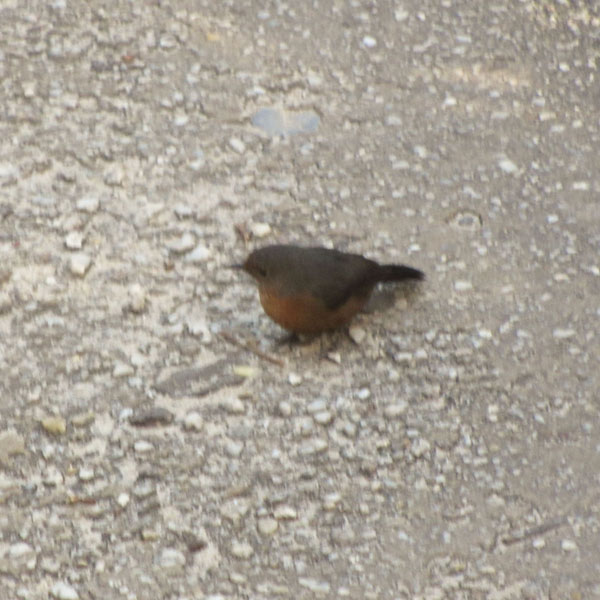
White-browed Scrubwrens, Large-billed Scrub-wrens, Brown Thornbills, Striated Thornbills, lots of Red Wattlebirds, White-eared Honeyeaters, White-naped Honeyeaters, beautiful New Holland Honeyeaters, and a shiny male Satin Bowerbird.
I took the afternoon off to walk about Katoomba and to hike down to the rock formation known as the Three Sisters. I saw a few birds along the way, but nothing new. The next morning I caught the train back to Sydney and after checking into my hotel for the night, walked in the very nice park along the river, south of the Sydney Airport. Among the new birds seen there were plentiful Silver Gulls, Rainbow Parakeets, and Noisy Miners.
The next morning I flew to Cairns and had time to hike to the Arboretum. There I was pleased to find Bush Stone Curlews, and an Orange-footed Scrubfowl. Toward evening I walked back along the Esplanade where there were Australian White ibis, a Black-fronted Dotterel, a Striated Heron and a few other shorebirds. Tomorrow I leave for Port Moresby, Papua New Guinea.
